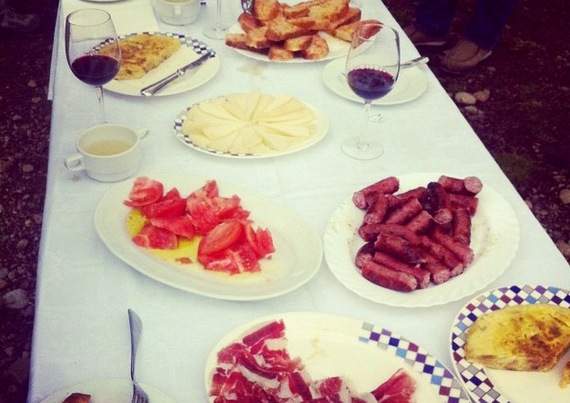Time stands still in Madrid's plazas. One moment you are walking down a narrow street packed with bars, and the next you are standing in an archway that leads to an open square full of people, history and voices. Those voices echo throughout the city, bouncing from Plaza de Espana to Puerta del Sol. When I studied abroad in Madrid years ago, I often dug my fork into a cold plate of tortilla de patatas in Plaza Mayor. I ate dinner at 11:00 at night and danced until the sun rose and sweat burned my eyes. Madrid drew me in to its web easily, and it didn't take long before I was tangled into a life of tapas, vino tinto, siestas and endless utterings of "vale."
Recently I returned to Madrid, with a slightly more mature palate and desire to explore different regions of food and wine. I still smiled at the sight of a bocadillo de calamari or tortilla de patatas in Madrid, but like the country, I knew there were more diverse culinary and wine experiences to explore. As a growing wine drinker, my goal was to leave with a better knowledge of Spanish wines and the process of producing them. This desire took me to the northern part of the country.
Although the Rioja region is probably most well known for its wine, Somontano, in the country's northwest corner, also produces some of the finest wines in Spain. I spent an evening in the town of Alquezar, where limestone streets and peeling facades turn into an emerald palace at night. The next day, wine was welcomed and in abundance. The contrasting climates and unique terrain in Somontano allow for some extraordinary wines. At Viñas del Vero's Secastilla vineyard, where vineyard and truffle can be arranged for the public, I could see the Pyrenees in the distance, covered in snow and ever beautiful. A local lunch on top of a mountain includes a 2009 Secastilla that is both earthy and refreshing, thanks to the land's Mediterranean microclimate. The vines, harvested completely by hand, are grown in a rocky soil at an over 2,000-foot elevation. Lunch highlights the best of local, fresh cuisine: hen stock, Spanish omelet, Iberian ham, "Sierra de Guara" sheep cheese, sausage called "longaniza de Graus", Ternasco lamb chops, a local dessert similar to pie called pumpkin "empanadico" and chocolate from Benabarre. What is it about cured Spanish ham that crystallizes perfectly at the edges and melts on the tongue at first bite?
You'd think I'd be done eating after this, but I was far from stopping. In the evening, a dinner at Blecua Vineyard of truffle-inspired dishes from Graus was decadence at its best. Chicken consommé was decorated with black truffle shavings. I sucked a truffle bon bon straight from my hand. How many people can say they've done that in their life? I delighted in the tenderness of a local lamb topped in excess with truffled bernaise sauce. Even dessert was a cotton candy with black truffle. I learned that the Blecua wine varietals are the result of a triple selection process of vineyard, barrel and grape selection. They include Spanish classics like Garnacha and Tempranillo, but my absolute favorite was the Viñas del Vero Gewürztraminer Colección 2001, which paired perfectly with just about every bite of food.
On the last end of my trip, I visit Haro in the province of La Rioja, where I could have easily spent a full week. The neighborhoods reminded me of the perfect fusion of both Madrid and Sevilla -- cosmopolitan with a sleepy, warm feel. A feast of tapas at a local restaurant included a Beronia Mazuelo Reserva with intense black fruits on the nose and fruit compote toasted coffee notes on the mouth. This wine paired well with just about every dish -- but especially the local Currado cheese that I could not seem to put down. For lunch the next day, I enjoyed a local dish called minestra de verduras, which is warm vegetable soup that included bits of Serrano ham, hearty chunks of cauliflower -- and really highlighted the fresh produce of the Rioja region.
On my way back to Madrid, I am enamored by the countryside of Bilbao, how flat land open fields lead to the lowest valleys and highest mountains. It is this same diverse terrain that has provided the backdrop to my first real experience of Spanish wines. I arrive back to Madrid for a final flamenco show at Casa de Patas. My heart raced at the sound of each foot tap on stage, just as it did ten years ago. The dancer, drenched in sweat, showed a passionate defiance in each movement. I lift my glass of vino tinto, feeling a little more knowledgeable than when I first arrived. That last sip and dance is a memory of Spain that I will always carry with me.
